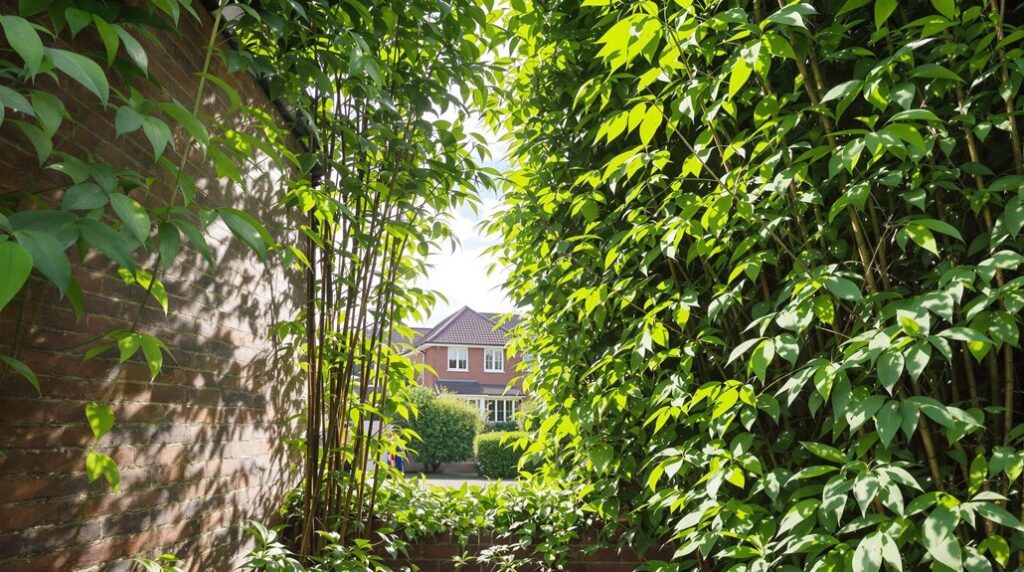I’ve encountered countless homebuyers who’ve walked away from potentially great properties the moment they hear “Japanese knotweed.” Here’s what’s interesting: most of these decisions are based on outdated fears rather than current evidence. The reality is that knotweed’s impact on property values and structural integrity isn’t nearly as catastrophic as the horror stories suggest. Before you dismiss that dream home, there are some critical facts about this plant that could completely change your perspective.
Key Takeaways
- Japanese knotweed rarely causes structural damage, with only 2%-6% of cases linked to building issues, making fears largely overblown.
- Properties with knotweed sell for 6.9% below asking price on average, but 41% experience no negative market impact.
- Certified treatment programs with insurance-backed guarantees provide viable solutions, typically spanning 3-5 years with professional management plans.
- Mortgage approval requires specialized brokers and treatment plans for infestations within 3 meters, but financing remains available.
- Legal disclosure is mandatory, and buyers gain negotiating leverage due to reduced competition and extended marketing periods.
Understanding Japanese Knotweed and Its Real Impact on Properties
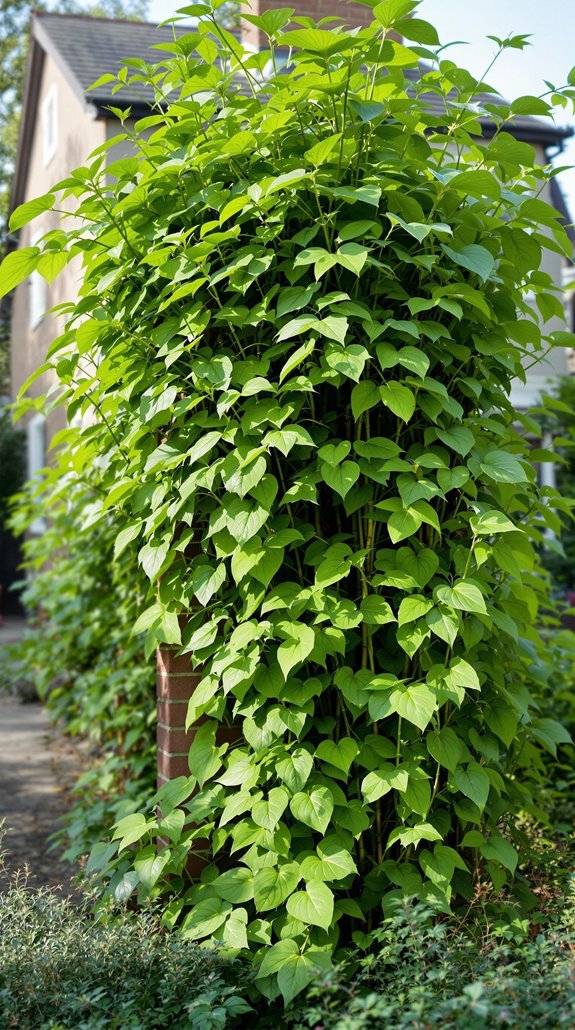
When you’re considering a property with Japanese knotweed, you’ll need to separate fact from fiction about this invasive plant’s actual impact. I’ve reviewed the scientific evidence, and here’s what you should know: only 2%-6% of cases actually link knotweed to building damage. Studies of 68 abandoned properties found no structural harm from knotweed presence.
The plant’s reputation exceeds its real threat to solid structures. While it grows rapidly—up to 3 inches daily—and spreads through extensive rhizome systems, its damage potential matches common woody plants. Large trees cause more structural issues than knotweed. Conducting a drainage survey can help identify other hidden issues that might affect the property.
Your primary concern should be ecological impact and property stigma, not catastrophic building damage. The widely-cited “7-meter rule” lacks scientific support, so don’t let fear-based assumptions drive your decision-making process. However, you must complete the TA6 form accurately when selling the property, as dishonest disclosure can lead to serious legal consequences.
Property Value Effects: Separating Myth From Reality
Despite widespread fears about Japanese knotweed‘s impact on property values, the actual data tells a more nuanced story. Properties with knotweed achieve 93.1% of asking price on average—a modest reduction that’s far from catastrophic.
Here’s what the numbers reveal: 41% of cases show no impact on price, demand, or time on market, while just over 40% report some impact. The severity depends on discovery timing—finding knotweed during marketing creates higher impact than pre-marketing identification. Additionally, the costs associated with home extension projects can also factor into overall property value considerations.
Treatment status matters greatly. Untreated infestations carry greater risk than professionally managed ones with insurance-backed guarantees. Proximity to structures and boundaries also influences impact severity. Property owners also face legal responsibilities if the invasive plant spreads from their land to neighboring properties.
The real challenge often lies in mortgage lender requirements and persistent stigma, even after successful treatment, rather than the plant’s actual structural threat.
Structural Damage Claims: What the Evidence Actually Shows
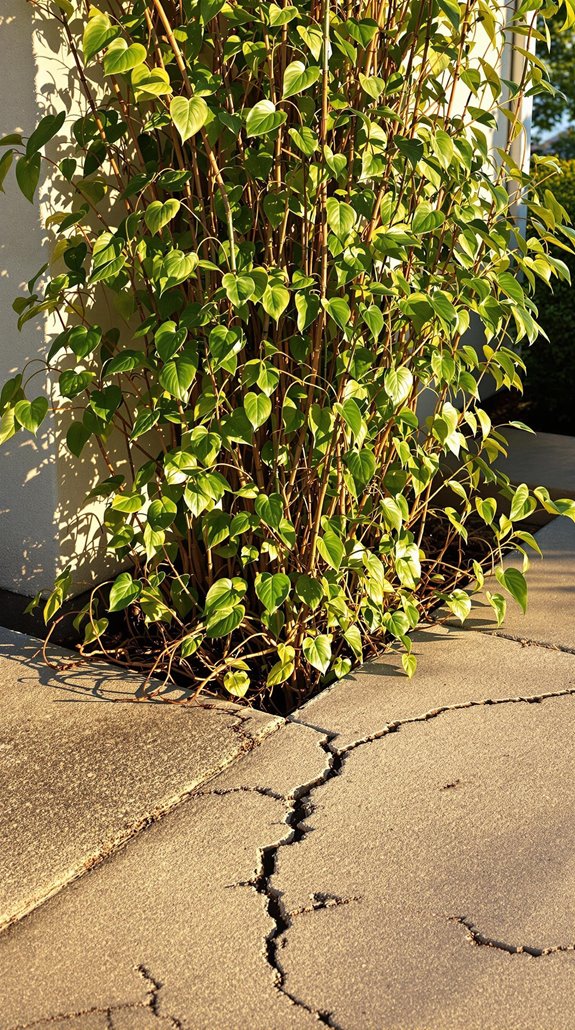
How severe is the structural damage that Japanese knotweed actually causes? I’ve examined the evidence, and it’s far less alarming than you’ve likely heard. Surveys of 122 properties show only 2-6% of professionals observed knotweed alongside structural damage—and that’s correlation, not causation.
The plant exploits existing weaknesses rather than creating them. Rhizomes grow into pre-existing cracks, but they don’t initiate damage to sound structures. When damage occurs, it’s typically minor issues like cracked brickwork or lifted paving, not structural collapse.
Here’s what matters: knotweed poses less risk than trees, which can cause subsidence and impact damage. The infamous “7-metre rule” lacks scientific support—75% of cases show rhizome spread under 2.5 metres. You’re dealing with an overstated threat. Properties near knotweed often show less damage than those near other invasive species.
Mortgage Lending Practices and Risk Assessment
While knotweed’s structural risks are overstated, mortgage lenders haven’t caught up with the science. I’ve seen over 35 UK lenders approve knotweed-affected properties, but their criteria remain inconsistent and often excessive.
Here’s what you’ll face: if knotweed sits within 3 meters of the property boundary, lenders demand certified treatment plans with insurance-backed guarantees. Beyond 3 meters, you’ll typically sail through without complications. The challenge lies in RICS categories 3-4 infestations, where you’ll need specialized brokers and detailed Knotweed Management Plans.
Treatment cycles require 3+ years, potentially stalling your purchase. Some lenders demand guarantees for knotweed 60 meters away—completely disproportionate to actual risk. Case-by-case assessments dominate, making outcomes unpredictable despite scientific evidence showing minimal structural threat. Legal disclosure requirements mean sellers must inform potential buyers of any knotweed problems before proceeding with the sale.
Misidentification Problems That Lead to Unnecessary Panic
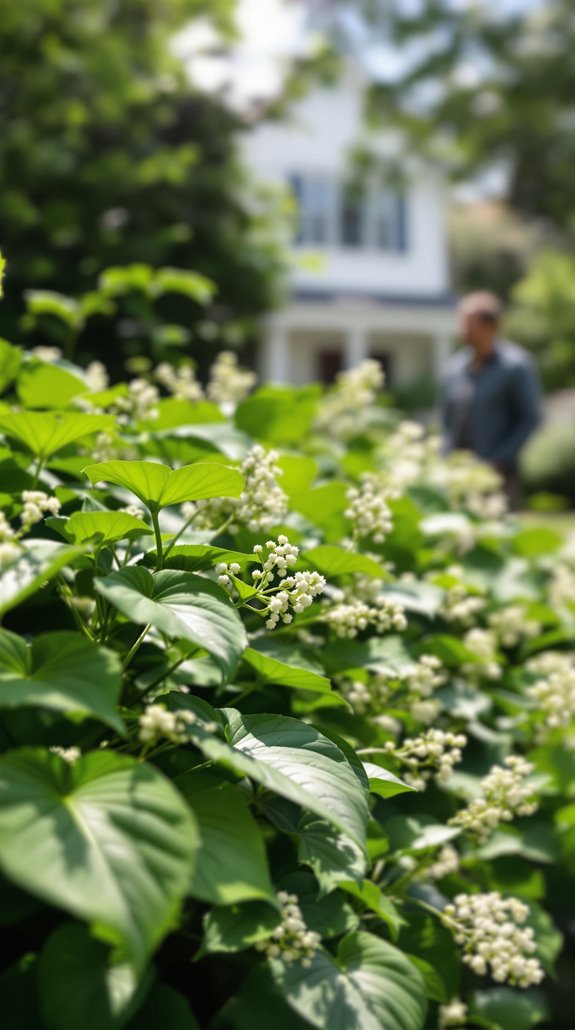
Beyond lender complications, you’ll face an even more fundamental problem: most suspected knotweed isn’t actually knotweed. Only 27% of plant photos submitted to specialists in 2025 were correctly identified as Japanese knotweed, meaning over 70% of homeowners panic unnecessarily.
I’ve seen bindweed, bamboo, and ivy repeatedly trigger false alarms during property inspections. Even dogwood and lilac shoots can fool untrained eyes. The real culprit? Superficial similarities in leaf shape and growth patterns, combined with our collective lack of knowledge about knotweed’s distinctive zigzag stems.
These misidentifications cost you real money through unnecessary specialist assessments, delayed property sales, and reduced property values. Before you panic, get professional identification. Most “knotweed problems” aren’t problems at all. The statistics show improvement from just 16% accurate identification in 2023, but the majority of homeowners still struggle with proper identification.
Treatment Options and Associated Costs
Five distinct treatment methods exist for Japanese knotweed, each with specific cost implications and effectiveness timelines. I’ll break down your options so you can make an informed decision.
Herbicide treatment offers the most reliable results but requires 3+ years of structured management. You’ll need professional application with insurance-backed guarantees—expect significant costs but proven effectiveness. The plant’s high tolerance to many substances means that alternatives like salt, bleach, and lime prove ineffective against established infestations.
Physical removal works for small infestations but demands intensive labor without guaranteed timelines. Every fragment must reach landfill to prevent regrowth.
Smothering uses thick plastic coverage for multiple years, blocking photosynthesis at minimal cost. It’s practical for small-to-medium areas.
Excavation provides immediate land access but requires ongoing monitoring and sufficient on-site space.
MeshTech represents an innovative, low-cost alternative showing promise for chemical-free treatment over 5+ years.
Legal Implications and Recent Court Cases

Understanding treatment costs represents just one aspect of managing Japanese knotweed—you’ll also need to navigate complex legal responsibilities that can expose you to significant financial liability.
While it’s not illegal to have knotweed on your property, you’re liable for civil prosecution if it encroaches onto neighboring land. As the landowner, you bear full responsibility—regulatory bodies won’t handle private land issues.
The Wildlife and Countryside Act 1981 makes causing knotweed to spread an offense, while the Environmental Protection Act 1990 classifies contaminated soil as controlled waste requiring proper disposal. Additionally, you must declare Japanese knotweed on the TA6 form during residential property sales.
Recent court cases, particularly Marc Davies v Bridgend Council, established that you can claim damages for property stigma even after successful eradication. If knotweed exists within 3m of boundaries, contact adjoining landowners immediately—it’ll impact your ability to sell or mortgage.
Market Dynamics: Sales Performance and Buyer Behavior
When Japanese knotweed affects a property’s marketability, you’re dealing with measurable impacts on both sale prices and buyer behavior that extend far beyond the physical presence of the plant itself.
I’ve found that over 40% of affected properties experience reduced sale prices, particularly when knotweed’s discovered during marketing. You’ll notice buyers become considerably more cautious, with 59% of cases experiencing extended marketing periods due to negotiations or withdrawals. Regularly managing knotweed growth can significantly improve perceptions and reduce buyer hesitance.
What’s interesting is that mortgage approvals often get delayed or denied when lenders identify knotweed, effectively shrinking your buyer pool. However, there’s encouraging news: 41% of prime properties still transact unaffected, and buyers increasingly accept managed knotweed with proper herbicide treatment plans as negotiable conditions rather than dealbreakers.
The ongoing stigma around knotweed continues to create psychological barriers that can deter potential buyers and lenders even when the plant is properly managed.
Professional Assessment and Management Strategies
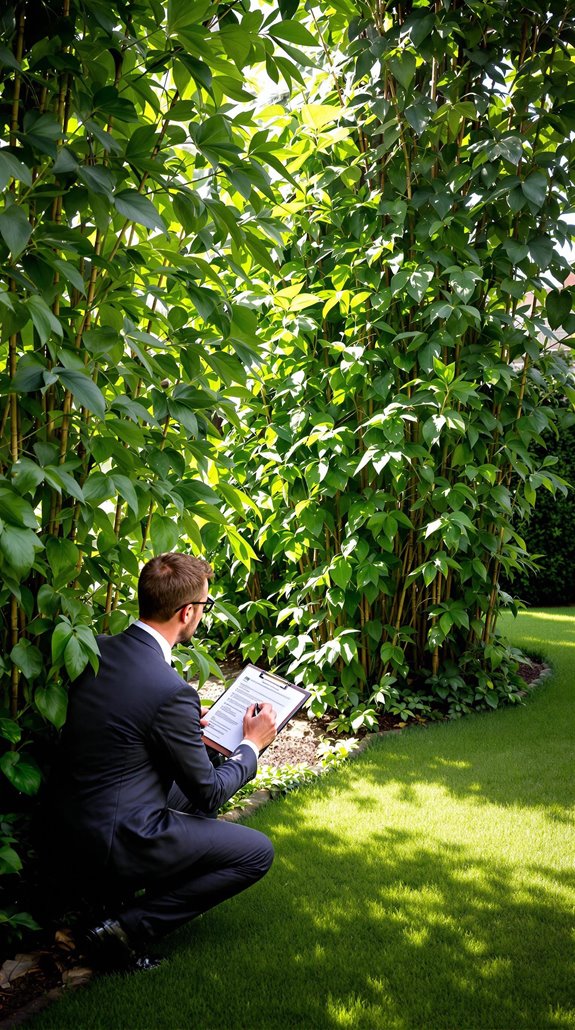
Given these market realities, you’ll need a thorough professional assessment to transform knotweed from a transaction barrier into a manageable condition. I recommend securing a PCA-accredited survey that satisfies RICS mortgage guidelines—this documentation proves you’re handling the situation professionally and keeps lenders on board.
Your surveyor will create distribution maps, assess structural damage risks, and classify the infestation by risk level using established decision trees. They’ll develop a custom management plan spanning 3-5 years, with fully itemized costs covering herbicide treatments and monitoring phases. You’ll receive insurance-backed guarantees for long-term efficacy, plus prevention protocols to stop off-site spread. Professional surveyors will also coordinate with adjacent land owners to ensure comprehensive treatment efforts across neighbouring properties. This professional approach turns a deal-killer into a documented, controllable issue that protects your investment.
Making an Informed Decision: Weighing Risks Against Opportunities
Armed with professional assessment data, you’re positioned to make a calculated decision that balances genuine risks against potential opportunities. I’ve analyzed the numbers: affected properties typically sell for 6.9% below asking price, while treatment costs vary considerably based on infestation severity.
Consider this perspective – you’re not just buying a problem, you’re potentially securing below-market value with manageable risk. The 41% of cases showing no market impact demonstrate that informed buyers can navigate these transactions successfully. Your key advantage lies in understanding what many buyers fear: knotweed rarely causes structural damage, and certified eradication programs offer genuine solutions. Additionally, understanding local planning regulations can help you evaluate the long-term potential of the property.
Calculate treatment costs against your purchase discount. If the mathematics work favorably, you’ve identified an opportunity others overlooked through fear rather than facts. Properties with knotweed infestations often experience increased time on the market, giving you additional negotiating leverage as a serious buyer.
Conclusion
I’d recommend you don’t let Japanese knotweed automatically disqualify a property from consideration. Get professional identification and assessment first—misidentification’s common. If it’s confirmed, factor treatment costs into your negotiations and guarantee there’s a management plan. The structural damage risk is typically overblown, and you’ll often secure better pricing. With proper due diligence and professional guidance, you can make this work to your advantage rather than viewing it as an insurmountable obstacle.
References
- https://pdf.euro.savills.co.uk/uk/spotlight-on/japanese-knotweed-and-prime-property—july-2021.pdf
- https://aecom.com/uk/press-releases/ecologists-find-no-evidence-japanese-knotweed-causes-significant-structural-damage/
- https://www.propertymark.co.uk/resource/data-shows-japanese-knotweed-consistently-mistaken.html
- https://www.japaneseknotweedspecialists.com/news/how-much-does-japanese-knotweed-devalue-property
- https://www.ceh.ac.uk/our-science/case-studies/japanese-knotweed-and-property-market
- https://www.pba-solutions.com/japanese-knotweed-news/japanese-knotweed-bad-news-for-property-sellers/
- https://www.groundworks.com/resources/japanese-knotweed-top-weed-for-home-damage-in-the-u-s/
- https://leaf.leeds.ac.uk/news/japanese-knotweed-is-no-more-of-a-threat-to-buildings-than-other-plants/
- https://kennedyslaw.com/en/thought-leadership/article/japanese-knotweed-has-its-reputation-grown-out-of-control/
- https://www.karmactive.com/japanese-knotweed-surge-up-to-15-property-value-loss-amid-super-growth/

